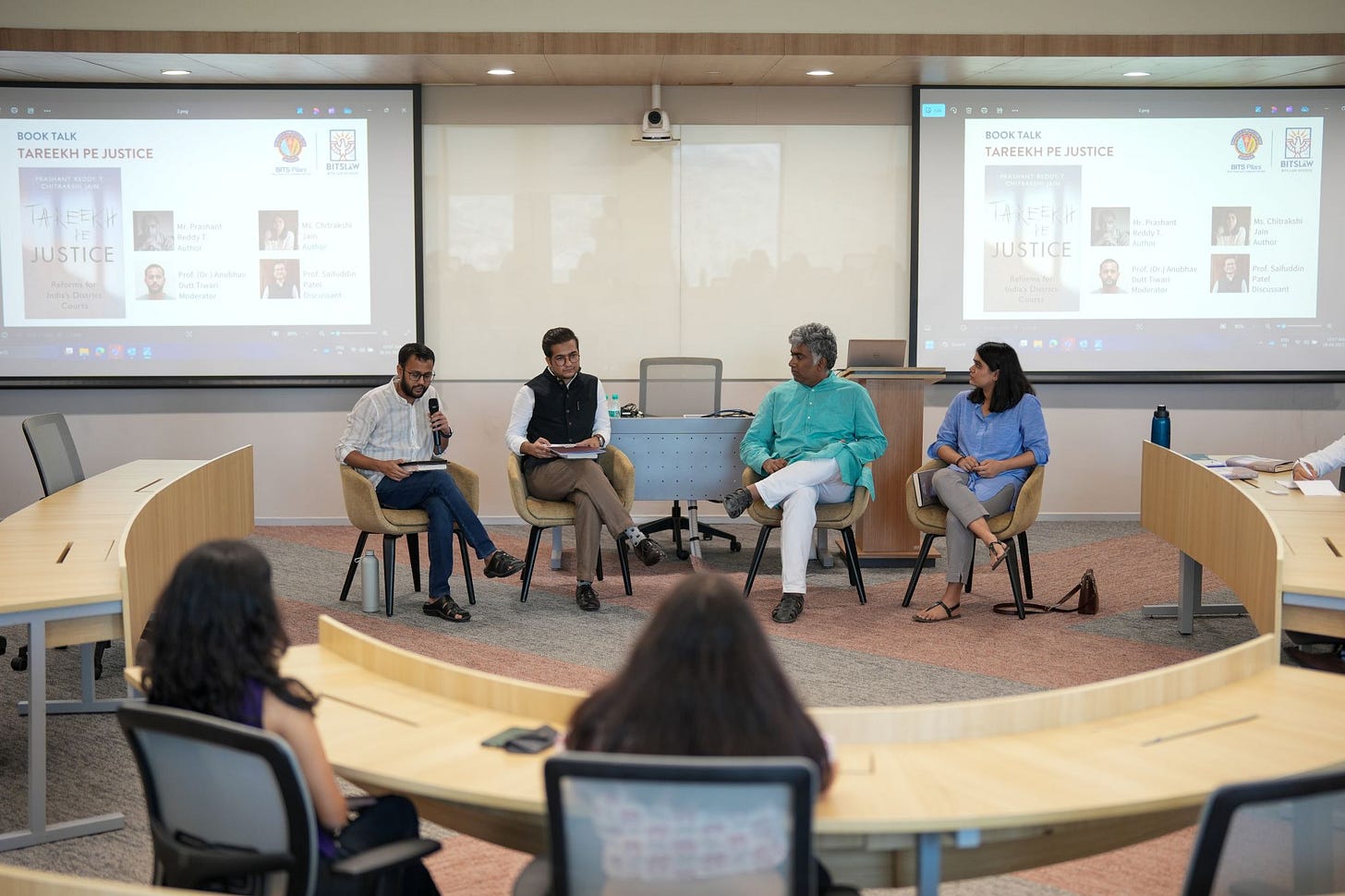Trainings at PPPF and Open Takshashila | Prepaid payment instruments | NLSIU AI & Law | IBC | New videos | The TrustBridge Newsletter | Issue 21
Pune Public Policy Festival | OpenTakshashila course | Legal transparency at RBI | Tareekh Pe Justice | Questions that matter - four new episodes
This is TrustBridge’s monthly newsletter. TrustBridge seeks to improve India’s business environment by improving the rule of law. This month, we’ve taken forward our work on building regulatory state capacity by examining how the RBI issues press releases regarding its enforcement orders and tracing the regulatory evolution of the payments ecosystem. We also conducted trainings on the theory and practice of regulation-making, and continued our exploration of how AI can be integrated into legal and regulatory systems. Our latest work, presented at the NLSIU AI & Law Forum, looks at how administrative law principles can guide the use of LLMs by regulators. We also continued our Dispute Resolution Dialogue series.
Read on to see what’s kept us busy this month.
Partnerships and collaborations
TrustBridge is delighted to have joined the AI Knowledge Consortium, a multi-stakeholder group of 16 research-driven organisations and think-tanks that seek to elevate AI governance in India, through participatory dialogues and research. You can sign up for their monthly newsletter and follow them on LinkedIn.
Trainings
The TrustBridge team will deliver a three-week online course titled ‘Using LLMs for Regulatory Analysis’ on OpenTakshashila from May 20 - June 6, 2025.
Natasha Aggarwal, Bhavin Patel, and Renuka Sane delivered a workshop titled ‘Introduction to, and Overview of, Regulatory Governance in India’ organised by the Pune Public Policy Festival on April 25 - 26, 2025. This included modules on market failure, cost-benefit analysis, rule of law, separation of powers, regulatory practice in India, and the theory of good regulation-making.
Past Events
TrustBridge hosted the third session of Dispute Resolution Dialogues on ‘Due Process Paranoia: An Impediment to Arbitration’s Future?’ by Mohammad Shahan Ulla on April 25, 2025.
Chitrakshi Jain discussed her co-authored book, Tareekh Pe Justice: Reforms for India’s District Courts, at book talks organised by XKDR and by BITS Law School on April 28, 2025, and with the Lallantop Channel on April 30, 2025.
Bhavin Patel and Amrutha Desikan presented their upcoming work on the use of LLM-based applications to assist regulators in writing better adjudicatory orders at the NLSIU AI & Law Forum on May 10, 2025. This project aims to recommend design principles for such applications to address potential negative impacts on administrative law principles in adjudicatory settings.
Blog posts
Renuka Sane and Amol Kulkarni published an article titled ‘Improving legal transparency at the RBI’ on the Leap Blog on April 29, 2025.
This opacity surrounding the RBI's adjudication process motivates our research. The extensive use of PRs to impose sanctions and a single PR to sanction more than one entity raises questions about clarity in disclosures regarding violations by regulated entities and the consistency of information related to sanctions. While it is a rule of law principle that orders should be put out in the public domain, to ensure know-ability of the law and foster consistency in decision making, we focus on improving at least the content of its PRs. It is easy to think of RBI's PRs as a mere corporate communication function, however, what RBI chooses to disclose by way of PRs is reflective of its broader approach to legal transparency.
In this article, we delve into the information disclosed in the RBI's PRs concerning enforcement actions against regulated entities. Furthermore, we investigate how central banks in different jurisdictions communicate sanctions and the level of detail they provide in their public disclosures. This comparative analysis allows us to benchmark the RBI's practices against international standards and identify best practices that could enhance transparency and accountability. Our analysis can form the basis for improving the RBI's disclosure framework. By adopting a more transparent approach to disclosing enforcement actions, the RBI can foster greater understanding and confidence in its regulatory processes.
Renuka Sane and Amol Kulkarni published an article titled ‘Prepaid Payment Instruments: How has regulation impacted market outcomes?’ on the Leap Blog on May 6, 2025.
Some may argue that with the advent of UPI, PPI was bound to lose market share. However, as this article shows, PPI was restricted by regulations, and did not get an opportunity to effectively compete with UPI, which on the other hand was booming on the back of regulatory relaxations, incentives, and zero fee mandates. One must also not forget that it was the non-banks which propelled UPI to unimaginable heights, and non-banks were also behind PPIs initial growth before the regulations hit them badly.
Op-eds
Renuka Sane co-authored an article with Ajay Shah for Business Standard, ‘We need to talk about China’ on April 27, 2025.
Domestically, simplistic adoption of the Chinese playbook -- import substitution, directed credit, state-led industrial policy, government subsidies -- should be resisted. These tools are attractive at first glance, but do not deliver economic development, as the Chinese distress shows. Instead, the Indian state needs to take measures to reduce regulatory uncertainty, enhance the enforceability of contracts, and create a stable environment for private investment. As global firms seek more predictable jurisdictions in which to diversify, India must achieve a rules-based, investor-friendly destination. Further, financial and macro policy in India needs to achieve a liquid and efficient financial market system, and macroeconomic stability (i.e. inflation stability and a floating exchange rate).
Renuka Sane wrote an article for The Print, ‘Bhushan Steel-JSW saga exposes cracks in insolvency code. Where’s the finality?’, on March 18, 2025.
The case was part of the list of high-profile insolvency proceedings identified by the Reserve Bank of India on 13 June 2017 for immediate resolution under the IBC. In hindsight, directing the RBI-12 cases—India’s largest and most complex defaulters—into the newly established IBC framework may have been premature. The code was still in its infancy, and the institutional capacity of NCLT, NCLAT, and other actors was untested. A more measured rollout, starting with smaller, less contentious cases, could have allowed the system to mature, rules to clarify, and precedents to stabilise. Instead, the RBI-12 exposed the system’s fragilities early on, creating a turbulent learning curve that continues to affect the IBC’s credibility today. That is a lesson for future reforms.
Videos
We published four episodes of the series ‘Questions That Matter’ on our YouTube channel:
Episode 4: Assessing Electricity Regulators – Insights from Tamil Nadu
Episode 5: SEBI’s Sanctions – Are Debarment and Restraint Orders Reasoned?
Episode 6: Fiscal Stress in Tamil Nadu – The Impact of Electricity Subsidies
Episode 7: Using LLMs for Regulatory Analysis
Thanks for reading The TrustBridge Newsletter! Subscribe for free to receive new posts and support our work.













